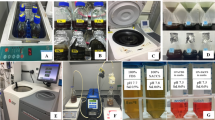Abstract
Clonorchis sinensis thrives on bile juice. The effects of bile and bile acids on newly excysted juvenile C. sinensis (CsNEJ) were studied in terms of survival. Survival of CsNEJs maintained in 1× Locke’s solution, Dulbecco’s modified Eagle’s medium, NCTC 109, Eagle’s, RPMI 1640, and 0.1% glucose was high, but dropped rapidly in 2× Locke’s, 0.85% NaCl, and phosphate-buffered saline. Most amino acids in the media favored CsNEJ survival; however, aspartic and glutamic acids and adenine reduced survival. Survival was also significantly lower in media containing more than 0.1% bile. CsNEJs preconditioned in low bile media survived longer in higher bile media. All bile acids and conjugated bile salts were found to favor CsNEJ survival, except for lithocholic acid (LCA) which was toxic. NCTC 109 medium was found to be optimal for the in vitro maintenance of CsNEJs and 1× Locke’s solution to be suitable for analyzing the biological effects of bioactive compounds and molecules. Based on these results, we propose that bile acids enhance activity of CsNEJs, but LCA deteriorate CsNEJs.






Similar content being viewed by others
References
Arundine M, Tymianski M (2003) Molecular mechanisms of calcium-dependent neurodegeneration in excitotoxicity. Cell Calcium 34:325–337
Bove KE, Heubi JE, Balistreri WF, Setchell KD (2004) Bile acid synthetic defects and liver disease: a comprehensive review. Pediatr Dev Pathol 7:315–334
Dixon KE (1966) The physiology of excystment of the metacercariae of Fasciola hepatica. Parasitology 56:431–456
Fried B, Laterra R, Kim Y (2002) Effect of exogenous glucose on survival and infectivity of Schistoma mansoni cercariae. Korean J Parasitol 40:55–58
Fried B, Schneck JL, Ponder EL (2004) Effects of tonicity, digestive enzymes and bile salts, and nutrient media on the survival EMC of Echinostoma caproni. Parasitol Res 93:1–4
Friedl FE (1961) Studies on larval Fascioloides magna. I. observation on the survival of rediae in vitro. J Parasitol 47:71–75
Golembewski EK, Samantha QW, Aurelian L, Yarowsky PJ (2007) The HSV-2 protein ICP 10PK prevents neuronal apoptosis and loss of function in an in vivo model of neurodegeneration associated with glutamate. Exp Neurol 203:381–393
Hong ST (2003) Clonorchis sinensis. International handbook of foodborne pathogens. CRC, New York, New York, pp 581–592
Kang IK, Lee SH, Seo BS (1969) Study on the 14C-glucose metabolism by Clonorchis sinensis. Korean J Parasitol 7:143–152
Kitada H, Miyata M, Nakamura T, Tozawa A, Honma W, Shimada M, Nagata K, Sinal CJ, Guo GL, Gonzalez FJ, Yamazoe Y (2003) Protective role of hydroxysteroid sulfotransferase in lithocholic acid-induced liver toxicity. J Biol Chem 278:17838–17844
Lackie AM (1975) The activation of infective stages of endoparasites of vertebrates. Biol Rev Camb Philos Soc 50:285–323
Li S, Chung BS, Choi MH, Hong ST (2004a) Organ-specific antigens of Clonorchis sinensis. Korean J Parasitol 42:169–174
Li S, Chung YB, Chung BS, Choi MH, Yu JR, Hong ST (2004b) The involvement of the cysteine proteases of Clonorchis sinensis metacercariae in excystment. Parasitol Res 93:36–40
Lun ZR, Gasser RB, Lai DH, Li AX, Zhu XQ, Yu XB, Fang YY (2005) Clonorchiasis: a key foodborne zoonosis in China. Lancet Infect Dis 5:31–41
Makishima M, Lu TT, Xie W, Whitfield GK, Domoto H, Evans RM, Haussler MR, Mangelsdorf DJ (2002) Vitamin D receptor as an intestinal bile acid sensor. Science 296:1313–1316
Manzerra P, Behrens MM, Canzoniero LM, Wang XQ, Heidinger V, Ichinose T, Yu SP, Choi DW (2001) Zinc induces a Src family kinase-mediated up-regulation of NMDA receptor activity and excitotoxicity. Proc Natl Acad Sci U S A 25:11055–11061
Ponder EL, Fried B (2004) Effects of glucose on survival, infectivity and linear movement of the cercariae of Echinostoma caproni. J Helminthol 78:185–187
Rim HJ (2005) Clonorchiasis: an update. J Helminthol 79:269–281
Sukhdeo MVK, Keith S, Mettrick DF (1988) The effects of bile on the locomotory cycle of Fasciola hepatica. J Parasitol 74:493–495
Acknowledgment
This work was supported by a grant R01-2006-000-10832-0 from the Basic Research Program of the Korea Science and Engineering Foundation.
Author information
Authors and Affiliations
Corresponding author
Rights and permissions
About this article
Cite this article
Li, S., Kim, T.I., Yoo, W.G. et al. Bile components and amino acids affect survival of the newly excysted juvenile Clonorchis sinensis in maintaining media. Parasitol Res 103, 1019–1024 (2008). https://doi.org/10.1007/s00436-008-1084-3
Received:
Accepted:
Published:
Issue Date:
DOI: https://doi.org/10.1007/s00436-008-1084-3




